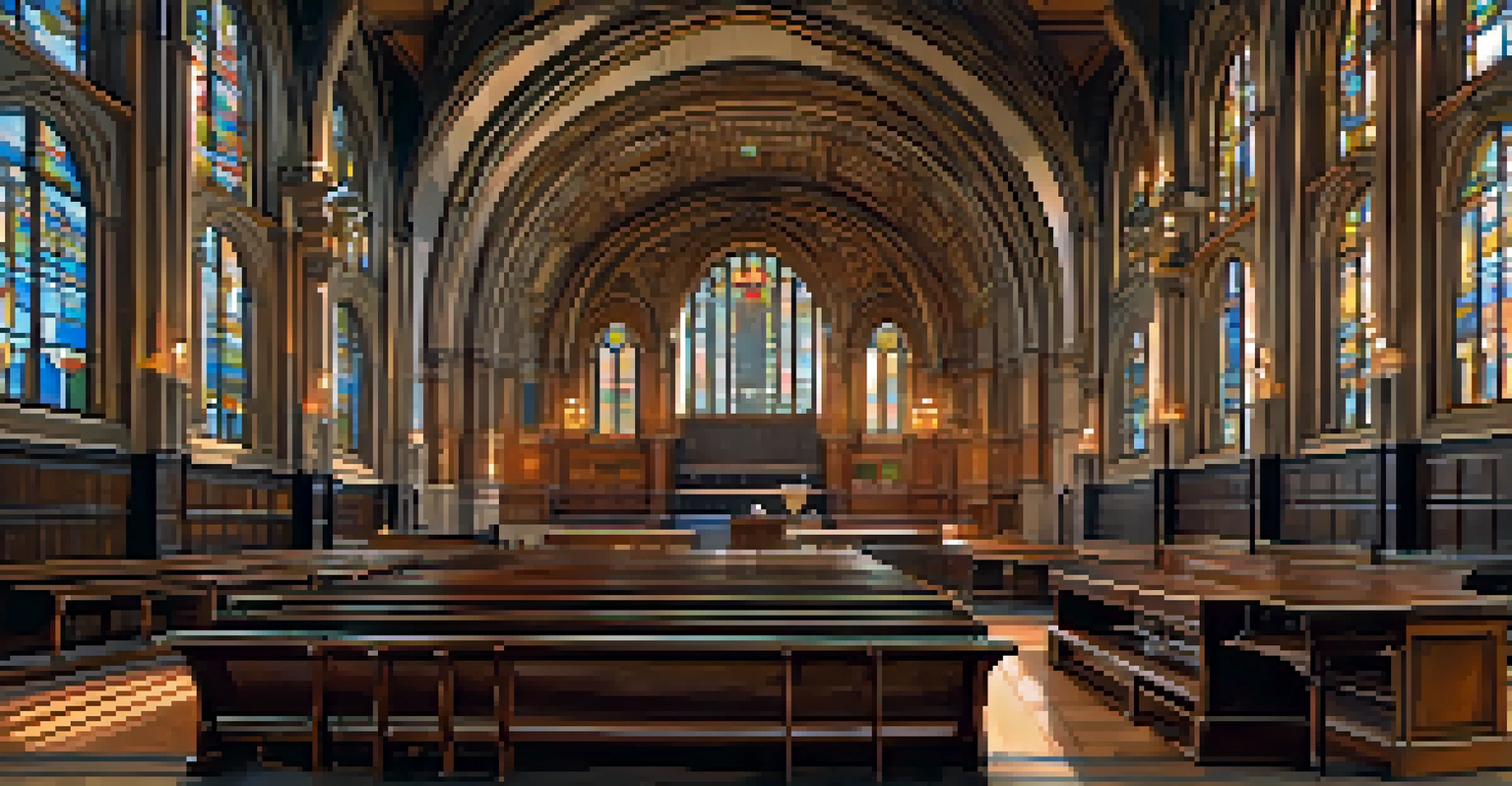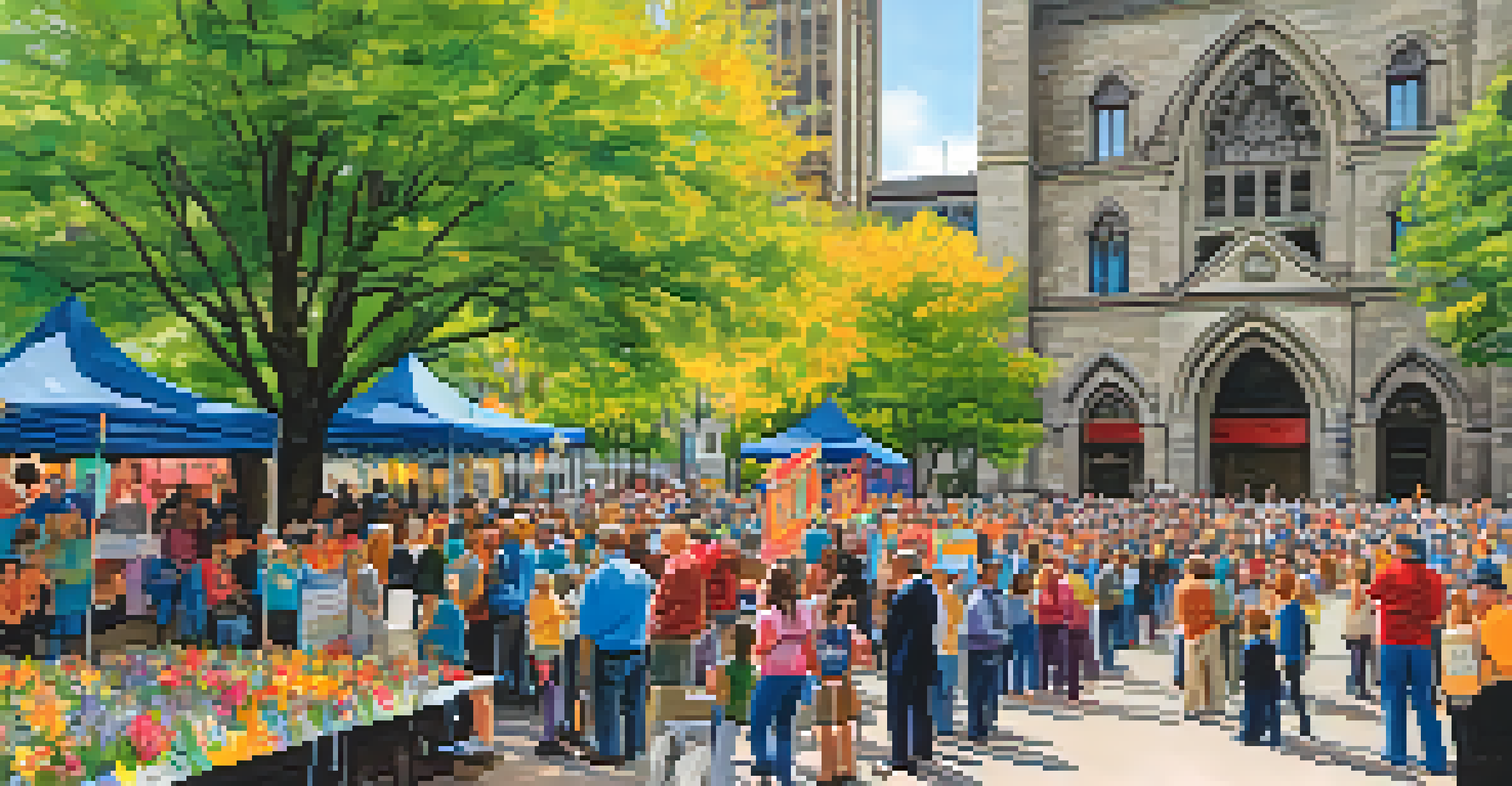The History Behind the Allegheny County Courthouse

An Architectural Marvel: The Design of the Courthouse
The Allegheny County Courthouse, located in Pittsburgh, is a stunning example of Richardsonian Romanesque architecture. Designed by architect Henry Hobson Richardson, the building features intricate stonework and a striking clock tower. It's not just a courthouse; it's a symbol of Pittsburgh's rich history and commitment to justice.
Architecture is the learned game, correct and magnificent, of forms assembled in the light.
Completed in 1888, the courthouse was part of a broader civic improvement movement during the late 19th century. This architectural style aimed to evoke a sense of stability and permanence, which was essential for public buildings of that era. The courthouse's bold design was meant to inspire trust in the legal system.
Over the years, the building's architectural features, such as its grand staircases and detailed carvings, have made it a beloved landmark. Visitors often marvel at its beauty, making it a favorite spot for photographs and local events. The courthouse serves as a testament to the artistry and craftsmanship of its time.
Historical Context: Pittsburgh in the Late 1800s
To understand the significance of the Allegheny County Courthouse, we need to look back at Pittsburgh in the late 1800s. This was a period of industrial growth, drawing immigrants and workers to the city for jobs in steel mills and factories. With this rapid expansion came the need for a robust legal system to manage an increasingly complex society.

The courthouse was built at a time when public confidence in the legal system was crucial. People wanted to see that their rights were protected and that justice was served fairly. The construction of such an impressive building reflected the community's aspiration for a reliable and respected judicial system.
Historic Courthouse Reflects Community
The Allegheny County Courthouse serves as a symbol of Pittsburgh's rich history and civic pride, embodying the community's aspirations for justice.
Moreover, the late 19th century was marked by a rising awareness of civic pride. The courthouse became a focal point for civic activities, where important events and gatherings took place. This connection to the community further solidified the courthouse's role as a cornerstone of Pittsburgh's identity.
Key Historical Events at the Courthouse
Throughout its history, the Allegheny County Courthouse has witnessed numerous significant events and trials. From high-profile criminal cases to landmark civil rights decisions, the courthouse has served as the backdrop for critical moments in Pittsburgh's legal history. Each trial added a layer to the courthouse's storied past.
A building has integrity just like a man. And just as seldom.
One notable event occurred in the early 20th century when the courthouse was the site of essential labor disputes. These trials highlighted the tensions between workers seeking rights and the industrialists who opposed them. The courthouse, therefore, became not just a venue for legal proceedings but also a symbol of the struggle for workers' rights.
Additionally, the courthouse has hosted various civic ceremonies and celebrations over the years. As a central hub for the community, it has been the site of everything from naturalization ceremonies to public protests, illustrating its ongoing importance in the fabric of Pittsburgh life.
The Courthouse's Role in Modern Justice
Today, the Allegheny County Courthouse continues to play a vital role in the local justice system. It houses several courts, providing a space where legal matters are resolved daily. This ongoing function reinforces its importance as a place where citizens seek justice and resolution.
In recent years, efforts have been made to modernize the courthouse while preserving its historical elements. Upgrades to technology and accessibility have been implemented, ensuring that the courthouse meets the needs of the 21st-century public without sacrificing its architectural integrity.
Key Role in Legal and Civic Events
Over the years, the courthouse has hosted significant legal trials and civic ceremonies, solidifying its status as a central hub for community engagement.
Moreover, the courthouse remains a popular destination for educational tours and community events. By engaging with the public, it fosters a deeper understanding of the legal system and the historical significance of the building itself. This connection to the community ensures that the courthouse remains relevant in today's society.
Preservation Efforts: Keeping History Alive
Preserving the Allegheny County Courthouse is crucial not only for its historical value but also for its architectural significance. Various preservation efforts have been undertaken to maintain the building's integrity, including restoration of its stone façade and interior features. These efforts help to keep the courthouse looking as majestic as it did over a century ago.
Local organizations and historical societies have played a significant role in advocating for preservation. They raise awareness about the courthouse's importance and promote initiatives to protect it from deterioration. Such community involvement highlights the collective pride Pittsburghers have in their historical landmarks.
In addition to restoration projects, educational programs are also designed to teach the public about the courthouse's history. By sharing stories and hosting events, these initiatives ensure that new generations appreciate and understand the significance of this historic building.
Architectural Features: A Closer Look
The architectural features of the Allegheny County Courthouse are a feast for the eyes and a testament to skilled craftsmanship. From its towering spires to the intricate stone carvings, every detail tells a story. The building's reddish-brown sandstone gives it a unique appearance, setting it apart from other public buildings in the area.
Inside, visitors are greeted by stunning stained-glass windows and grand courtrooms that evoke a sense of awe. These design elements were intentionally included to reflect the dignity of the judicial process. The courthouse doesn't just serve its practical function; it also embodies the values of justice and fairness.
Modernization and Preservation Efforts
Ongoing modernization efforts ensure the courthouse meets contemporary needs while preserving its historical architecture and significance.
Moreover, the building's layout is designed to facilitate the workings of the legal system. With designated spaces for various court functions, the design promotes efficiency and accessibility. This careful planning underscores the importance of functionality in architectural design, particularly for public institutions.
The Courthouse Today: A Community Hub
In recent years, the Allegheny County Courthouse has evolved into more than just a legal building; it has become a community hub. Local events, art exhibitions, and public forums are frequently held within its walls. This transformation reflects a broader trend of public buildings serving multiple roles within their communities.
The courthouse also plays host to seasonal celebrations and cultural events, drawing in residents and visitors alike. These activities foster a sense of community, encouraging people to gather and engage with the space in meaningful ways. It's a reminder that the courthouse is not just a place for legal proceedings; it's a center for civic life.

As Pittsburgh continues to grow and change, the Allegheny County Courthouse remains a steadfast symbol of the city's history and future. Its ability to adapt while maintaining its historical significance is a testament to the resilience of both the building and the community it serves.